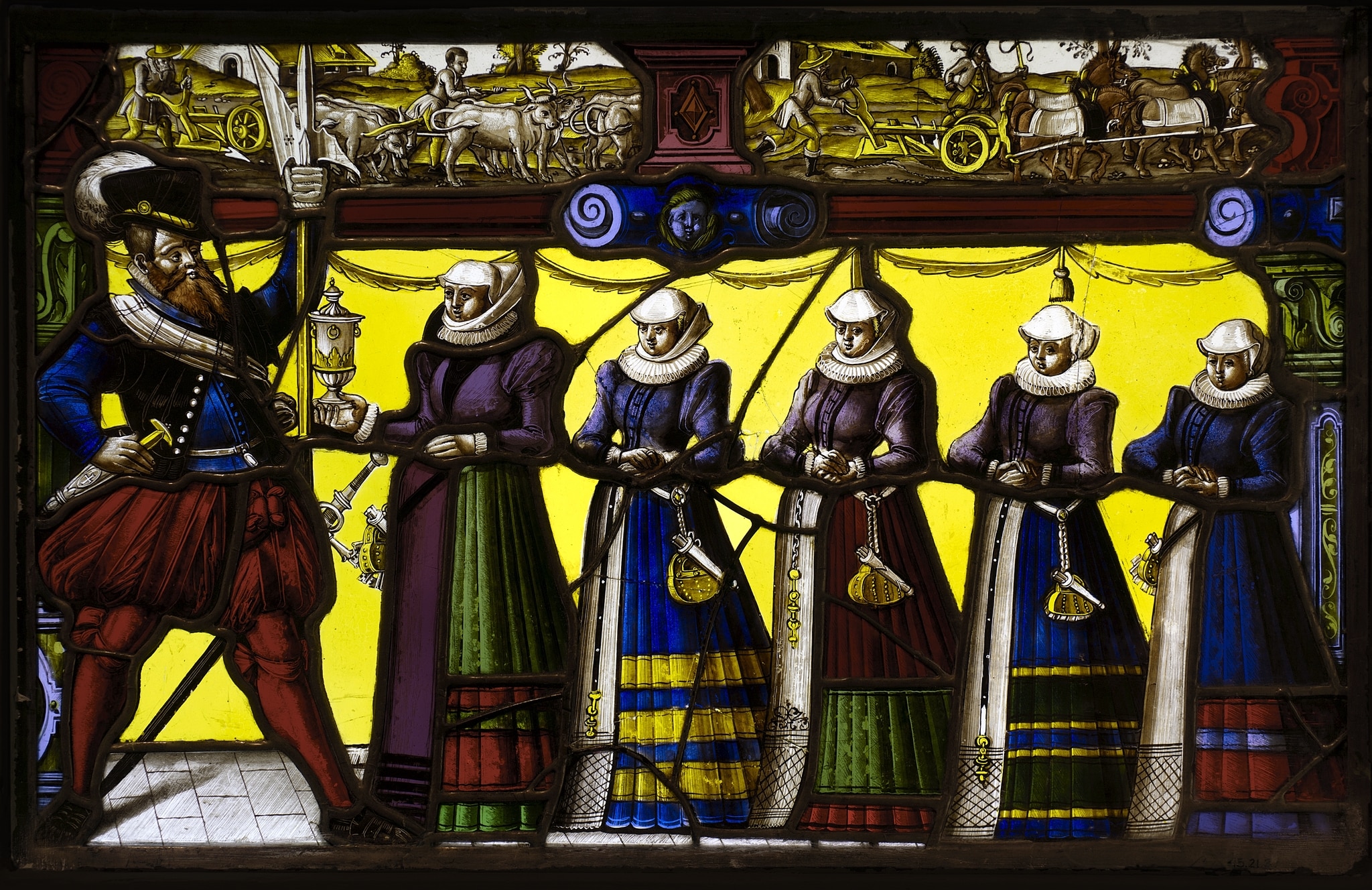On the left, the wealthy farmer is dressed in a black hat with a white plume, a blue jacket with a black waistcoat and white sash, red breeches and hose, and black shoes. He holds a pike in his left hand and rests his right hand on his “dolch,” the knife at his waist. Facing him, his wife presents a silver cup trimmed in gold. Behind her are their four daughters. The stance and dress of the women are almost identical, but vary in color. They wear white coifs and ruffs at neck and wrist, over dresses with tight-fitting bodices and puffy sleeves at the shoulders. Their headdresses mark them as married women. The long skirts are split in the front to display petticoats. Those of the daughters are white, while the wife’s is a deep purple that corresponds to her bodice. The wife and her oldest daughter both wear wimples. From each of the daughter's belts hangs a pouch and a scabbard, probably containing eating utensils such as a small knife and fork. In addition to these items, keys hang from the wife’s belt, indicating her responsibility for the household. Supported by the simple architectural frame, activities of a prosperous farm appear above. On the left is a scene of plowing with a team of oxen, on the right, one with horses. The wealth of the farmer is demonstrated by his having teams of six animals to draw each plow. The function of such panels would seem to be commemorating siblings and honoring parents, since the children are shown without their spouses.
The Los Angeles work is in many ways analogous with a panel of Anna Müller and her sons dated 1599 (Metropolitan Museum of Art). The attribution of the Metropolitan’s panel to Franz Fallenter, who was responsible for almost all the panels in the Rathausen series, however, seems questionable (Metropolitan Museum of Art, 64.101.1592; Boesch, 1955, p. 137, fig. 77; Hayward, 1989, p. 165; Raguin, 1998, pp. 56–57, fig. I.17). The panel shows a widowed mother standing at the left, looking at her five grown sons dressed in their parade best. Above is a scene of farm work showing a team of horses drawing a plow followed by a horse harrowing the ground. A similar panel from Toggenburg, dated 1612, shows a widow, Barbel Hofstetter, and her four children (Zurich, Schweizerisches Nationalmuseum, formerly Basel, Historisches Museum; Boesch, 1935, pp. 37–38, fig. 9, no. 82). She stands on the right and to her left are her three sons, holding their weapons, two with rifles, one with a halberd. They pose with their legs staunchly apart and wear similar plumed hats and puffy breeches. A married daughter, whose name is given as Barbel Blümli, stands on the right. She is behind her mother and performs the same greeting gesture of offering a cup as the wife in the LACMA panel. All individuals are named in the inscription below, an expected feature which was lost from the LACMA panel. This is the single documented Toggenburg panel that is in this horizontal format. Boesch commented that it is similar to the panel in the Helbing sale, that is, the present LACMA panel (Boesch, 1935, p. 37, n. 1).
Uta Bergman has suggested a possible Aargau origin for other panels of this type. She associates a panel of Caspar Fischer and Barbara Haas dated 1613 (Museum in der Burg Zug, Inv.-No. 7083: Bergmann, 2004, pp. 257–58, no. 71) with the aforementioned panel of Anna Müller and her sons. Here we see strong similarities in the three-dimensionality of the forms and the deft removal of wash in the delineation of the bodice and skirt. A horizontal panel carrying the names of S. Petter Remundt and Bend[...]cht Zedo in the Schweizerische Nationalmuseum (Schneider, 1970, p. 272, no. 441), dated about 1600, shows similar yellow ground, poses of husbands and wives, and, in particular a farming scene at the top. The couple wears very different headgear, however.
Cited in:
LACMA Quarterly, 1945, pp. 5–10.
Normile, 1946, pp. 43–44.
Hayward, 1989, p. 70.
Raguin, 2024, vol. 1, pp. 41, 189–92.
